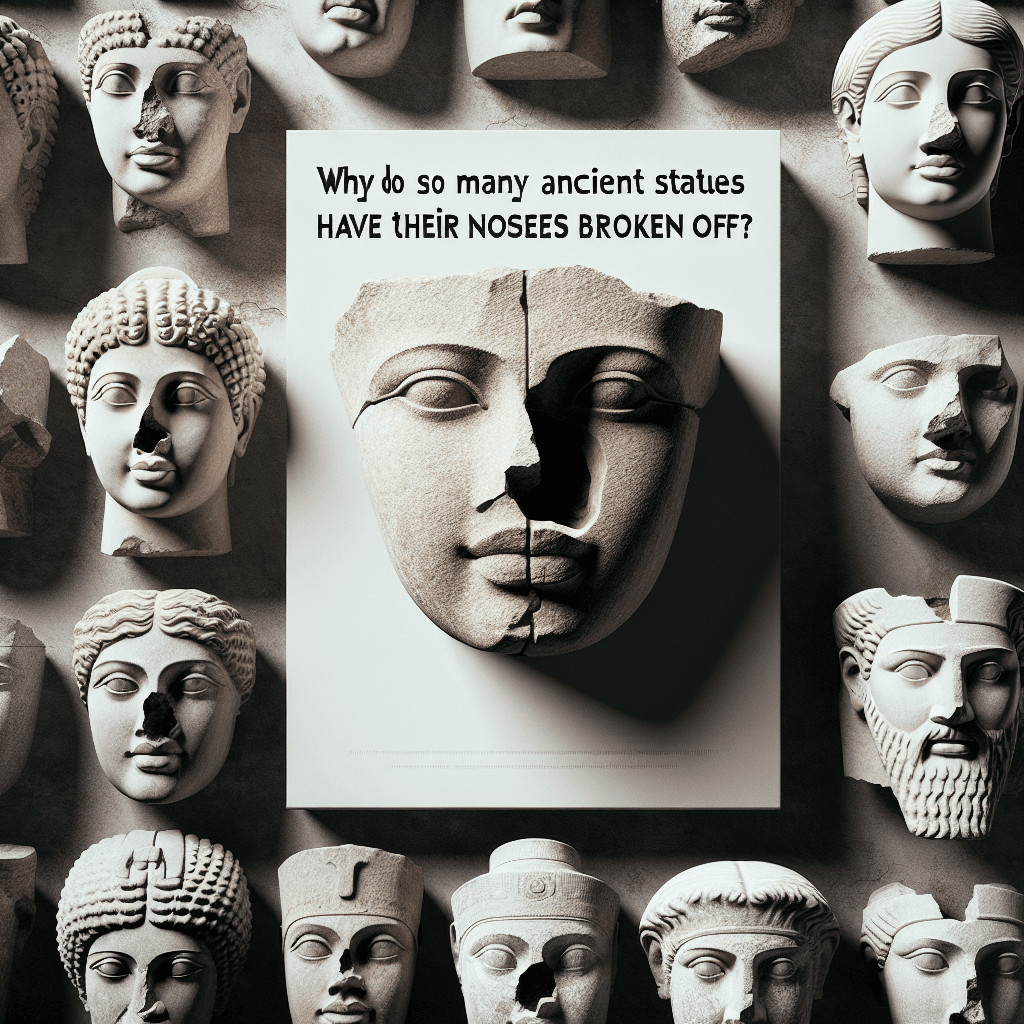Why do so many ancient statues have their noses broken off
It wasn't just the passage of time that broke these ancient noses. The truth is far more deliberate, revealing a targeted effort to rob these figures of their power and presence.


Too Long; Didn't Read
TLDR: It is a mix of natural decay and deliberate destruction. As prominent, fragile features, noses break off easily over millennia. However, many were also intentionally smashed for political or religious reasons, either to erase a ruler's memory or to symbolically kill the spirit believed to live in the statue.
More Than Just Wear and Tear: Why Do So Many Ancient Statues Have Their Noses Broken Off?
Have you ever wandered through a museum, gazing into the stone eyes of a Roman emperor or an Egyptian pharaoh, and noticed something conspicuously absent? The nose. It’s a strangely common feature among ancient sculptures, from the halls of the Louvre to the tombs of the Valley of the Kings. A popular assumption is that this is simply the result of millennia of accidents and erosion. While that’s part of the story, the truth is often more deliberate, violent, and fascinating. This post will delve into the complex reasons behind the widespread phenomenon of the noseless statue, revealing a history of conflict, belief, and symbolic destruction.
The Obvious Culprit: The Ravages of Time
Let’s start with the simplest explanation. Statues are old, and time is not kind. The nose is one of the most prominent and fragile features of any sculpture. As a protruding part, it's naturally the most vulnerable to damage. Over thousands of years, many statues have been:
- Toppled: Whether by earthquakes, invasions, or simple decay, once a statue falls face-first, the nose is often the first thing to break.
- Buried and Rediscovered: Many artifacts spent centuries buried underground. The pressure of the earth, combined with the often-incautious methods of early archaeologists and treasure hunters, could easily lead to damage.
- Eroded: For statues left exposed to the elements, centuries of wind, rain, and sandblasting would naturally wear away the most delicate features first.
This accounts for a significant number of broken noses. It's the inevitable, accidental damage that comes with surviving antiquity. However, it fails to explain the sheer consistency and, in many cases, the precision of the damage.
A Deliberate Attack: Iconoclasm and Political Vandalism
Many broken noses are not accidents but scars from deliberate acts of destruction, a practice known as iconoclasm. In the ancient world, a statue was rarely just a piece of art; it was a powerful symbol.
Political and Personal Defacement
In cultures like ancient Rome, statues of emperors and powerful figures were expressions of their authority. To deface a statue was to attack the person and their legacy. When a new emperor took power or a ruler was posthumously disgraced, a practice called damnatio memoriae (condemnation of memory) was often enacted. This involved systematically erasing the fallen figure from public life. Their statues would be torn down, and their faces—especially the nose and eyes—would be smashed to symbolically rob them of their dignity and power. It was a clear political statement: you are no longer in control, and you will be forgotten.
Religious Iconoclasm
Conflict between religions has also left its mark on ancient art. As Christianity spread through the Roman Empire, many early Christians viewed the statues of Roman and Greek gods and goddesses as pagan idols that needed to be destroyed. They systematically targeted these "false gods," often breaking their noses as a way of de-sanctifying them. Later, in regions that came under Islamic rule, a similar pattern emerged, as some interpretations of Islam discourage the depiction of human or divine figures, leading to the defacement of pre-existing figurative art.
Killing the Spirit: The Egyptian Belief
Perhaps the most fascinating reason for targeted nose-breaking comes from ancient Egypt. For the Egyptians, statues had a profound spiritual function. They believed a statue of a person or deity could serve as a vessel for that entity's spirit or life force, known as the ka. A statue wasn't just a representation; it was a conduit through which the spirit could receive offerings and interact with the world of the living.
According to research highlighted by curators like Edward Bleiberg of the Brooklyn Museum, the nose was considered the pathway for the breath of life. To destroy the nose was to suffocate the spirit within the statue.
This wasn't random vandalism. It was a targeted, ritualistic act. Tomb robbers would break the noses of statues of the deceased to prevent their spirits from seeking revenge. Political rivals would deface the statues of pharaohs to disable their power, even in the afterlife. By "killing" the statue, they believed they were neutralizing its spiritual threat for good. This explains why on many Egyptian artifacts, the damage is so precise—the nose is carefully chiseled off while the rest of the face remains largely intact.
A Story in the Stone
So, why do so many ancient statues have their noses broken off? There is no single answer. The missing nose might be an unfortunate accident of history, a casualty of the statue falling from its pedestal centuries ago. Or, it could be a deliberate scar, a clue to a story of political overthrow, religious fervor, or a deep-seated spiritual belief in the power of the image. The next time you stand before a noseless statue, look closer. You aren't just seeing damage; you are seeing a tangible piece of history, a silent testament to the forces that shaped, and ultimately tried to unmake, the ancient world.
More Articles

Why do movie punches sound so much crunchier and louder than real ones?
That sickening, bone-crunching punch you hear in the movies is a lie, and the secret ingredient is probably sitting in your refrigerator right now.

What makes a beer bottle suddenly foam over just from a light tap on top?
It’s not magic, it’s a shockwave; discover the explosive physics that turns a gentle tap on your beer bottle into an instant foamy geyser.

Why do police officers touch the back of a car during a traffic stop?
It’s not a random habit; that simple touch is a calculated, old-school tactic designed to leave a crucial and potentially life-saving piece of evidence behind.